Optimizing Phosphorus Fertilization Management Is Conducive to Improving Alfalfa Yield and Quality: A Meta-Analysis
Abstract
1. Introduction
2. Materials and Methods
2.1. Data Sources
2.2. Data Classification
2.3. Data Analysis
2.3.1. Calculation of Effect Size
2.3.2. Heterogeneity Test
2.3.3. Analysis of Influencing Factors
2.3.4. Data Processing
3. Results and Analysis
3.1. Data Distribution and Overview
3.2. Comprehensive Effects of Phosphorus Fertilization on Alfalfa Yield and Quality
3.3. Analysis of Factors Influencing Alfalfa Yield with Phosphorus Fertilization
3.3.1. Regional Factors
3.3.2. Phosphorus Application Factors
3.3.3. Nitrogen Application Factors
3.3.4. Time Factors
3.4. Analysis of Factors Affecting the Quality of Alfalfa by Phosphorus Fertilizer Addition
3.4.1. Crude Protein Content
- (1)
- Regional Factors
- (2)
- Phosphorus Application Factors
- (3)
- Nitrogen Application Factors
- (4)
- Time Factors
3.4.2. Acid Detergent Fiber (ADF) Content
- (1)
- Regional Factors
- (2)
- Phosphorus Application Factors
- (3)
- Nitrogen Application Factors
- (4)
- Time Factors
3.4.3. Neutral Detergent Fiber (NDF) Content
- (1)
- Regional Factors
- (2)
- Phosphorus Application Factors
- (3)
- Nitrogen Application Factors
- (4)
- Time Factors
4. Discussion
4.1. Effect of Regional Factors on Yield and Quality of Phosphorus-Applied Alfalfa
4.2. Effect of Phosphorus Fertilizer Factors on Yield and Quality of Phosphorus-Applied Alfalfa
4.3. Effect of Nitrogen Fertilizer Factors on Yield and Quality of Phosphorus-Applied Alfalfa
4.4. Effect of Time Factor on Yield and Quality of Phosphorus-Applied Alfalfa
5. Conclusions
- (1)
- Compared with no phosphorus fertilization, the yield, CP content, and NDF content of alfalfa with phosphorus addition increased significantly by 19.0%, 7.2%, and 7.2% on average, respectively, while the acid detergent fiber (ADF) content decreased significantly by 3.3% on average.
- (2)
- In regions such as Shandong, Jilin, and Hebei, with soil pH 7–8, annual precipitation of 200–400 mm, average annual temperature > 4 °C, and altitude of 500–1000 m, applying calcium phosphate or single superphosphate with a P2O5 content of 0–20% at a rate of 100–200 kg·ha−1 as a basal application, nitrogen application > 100 kg·ha−1, and one topdressing during an experimental and establishment duration of 2 years was conducive to increasing alfalfa yield with phosphorus addition.
- (3)
- In Xinjiang, with soil pH > 8, annual precipitation > 200 mm, average annual temperature 6–8 °C, and altitude of 500–1000 m, applying calcium phosphate with a P2O5 content of 0–20% at a rate of 100–200 kg·ha−1 as a basal application without nitrogen fertilization during a 2-year experimental period and 2–3 years of establishment was conducive to increasing CP content in alfalfa with phosphorus addition.
- (4)
- In Xinjiang, with soil pH <8, annual precipitation 0–200 mm, average annual temperature 6–8 °C, and altitude of 0–500 m, applying mono-ammonium phosphate with a P2O5 content > 20% at a rate of 200–300 kg·ha−1 with one topdressing and no nitrogen fertilization during a 1-year experimental period and 3 years of establishment was conducive to reducing the ADF content in alfalfa with phosphorus addition.
- (5)
- A nitrogen-to-phosphorus ratio of 0.4–0.6 was conducive to reducing the NDF content in alfalfa with phosphorus addition.
Author Contributions
Funding
Data Availability Statement
Acknowledgments
Conflicts of Interest
References
- Zhang, T.C.; Wan, W.F.; Sun, Z.; Li, H.G. Phosphorus uptake and rhizosphere properties of alfalfa in response to phosphorus fertilizer types in sandy soil and saline-alkali soil. Front. Plant Sci. 2024, 15, 1377626. [Google Scholar]
- Liu, H.; Xu, M.; Guo, Y.; Dan, Z.; Liu, X.; Zhang, J.; Li, C.; Jia, S.; Jia, L.; Yu, A.; et al. Combined Transcriptome and Metabolome Analysis of Alfalfa Responses to Aphid Infestation. Agriculture 2024, 14, 1545. [Google Scholar] [CrossRef]
- Li, Y.; Wang, X.-B.; Ma, J.; Yang, X.; Lu, X.; Feng, Q.; Hou, F. Effects of planting year of alfalfa on rhizosphere bacterial structure and function. Rhizosphere 2024, 29, 100839. [Google Scholar]
- Xie, H.L.; Yang, Y.P.; Dong, Y.; Wang, T. Analysis of the International Development Trends of Alfalfa. Chin. Bull. Bot. 2021, 56, 740–750. [Google Scholar]
- Ni, Y.F.; Wang, M.L. Trends and comparative analysis of pasture production in China from a cost-benefit perspective. Chin. J. Grassl. 2024, 46. [Google Scholar]
- Rahman, M.A.; Humayan, K.A.; Yowook, S.; SangHoon, L.; Mirza, H.; KiWon, L. Nitric Oxide Prevents Fe Deficiency-Induced Photosynthetic Disturbance, and Oxidative Stress in Alfalfa by Regulating Fe Acquisition and Antioxidant Defense. Antioxidants 2021, 10, 1556. [Google Scholar] [CrossRef]
- Lu, E.; Li, C.; Geng, Y.; Liang, T.; Zhang, J. Effects of Long-Term Fertilization on Phosphorus Form and Availability in Black Soil. Appl. Sci. 2024, 14, 11673. [Google Scholar] [CrossRef]
- Padmanabhan, P.; Sahi, S.V. Influence of phosphorus nutrition on growth and metabolism of Duo grass (Duo festulolium). Plant Physiol. Biochem. 2008, 47, 31–36. [Google Scholar]
- Ghorbani, M.; Amirahmadi, E. Biochar and soil contributions to crop lodging and yield performance—A meta-analysis. Plant Physiol. Biochem. 2024, 215, 109053. [Google Scholar]
- Schulze, J.; Temple, G.; Temple, S.J.; Beschow, H.; Vance, C.P. Nitrogen Fixation by White Lupin under Phosphorus Deficiency. Ann. Bot. 2006, 98, 731–740. [Google Scholar] [CrossRef]
- Ke, X.; Xiao, H.; Peng, Y.; Wang, J.; Lv, Q.; Wang, X. Phosphoenolpyruvate reallocation links nitrogen fixation rates to root nodule energy state. Science 2022, 378, 971–977. [Google Scholar] [CrossRef] [PubMed]
- Ma, X.; Li, H.; Zhang, J.; Shen, J. Spatiotemporal Pattern of Acid Phosphatase Activity in Soils Cultivated With Maize Sensing to Phosphorus-Rich Patches. Front. Plant Sci. 2021, 12, 650436. [Google Scholar] [CrossRef] [PubMed]
- Murray, J.D.; Liu, C.W.; Chen, Y.; Miller, A.J. Nitrogen sensing in legumes. J. Exp. Bot. 2017, 68, 1919–1926. [Google Scholar] [CrossRef]
- Hewitt, M.M.; Carr, J.M.; Williamson, C.L.; Slocum, R.D. Effects of phosphate limitation on expression of genes involved in pyrimidine synthesis and salvaging in Arabidopsis. Plant Physiol. Biochem. 2005, 43, 91–99. [Google Scholar] [CrossRef] [PubMed]
- Plaxton, W.C.; Tran, H.T. Metabolic adaptations of phosphate-starved plants. Plant Physiol. 2011, 155, 1006–1015. [Google Scholar] [CrossRef] [PubMed]
- Guo, Y.; Wang, Z.; Li, J. Effects of phosphorus fertilizer type and dripline depth on root and soil nutrient distribution, nutrient uptake, and maize yield under subsurface drip fertigation. Field Crops Res. 2024, 318, 109585. [Google Scholar] [CrossRef]
- Zhou, C.; Cai, Y.; Yang, Z.; Wang, H.; Deng, F.; Bai, Z.; Gong, W.; Wang, J. Nitrogen, phosphorus and potassium fertilization promotes Zanthoxylum armatum ‘Hanyuan Putao Qingjiao’ flower bud differentiation in Sichuan, China. Hort. Environ. Biotechnol. 2020, 61, 651–661. [Google Scholar] [CrossRef]
- El Mazouni, N.; Mesnaoui, M.; Labbita, T.; El Mokhtar, M.A.; Khouloud, M.; Meddich, A. Formulating a Fertilizer Based On Vitreous Fertilizers and Arbuscular Mycorrhizal Fungi to Improve Wheat Growth and Yield Under Water Stress. J. Crop Health 2024, 77, 13. [Google Scholar]
- Bouas, H.; Bouaziz, A.; Bouazzama, B.; Hirich, A.; Choukrallah, R. How Phosphorus Fertilization Alleviates the Effect of Salinity on Sugar Beet (Beta vulgaris L.) Productivity and Quality. Agronomy 2021, 11, 1491. [Google Scholar] [CrossRef]
- Lima, G.S.; Silva, S.S.; Soares, L.A.A.; Silva, A.A.R.; Gheyi, H.R.; Nobre, R.G.; Souza, W.B.B.; Silva, S.T.A.; Guedes, M.A.; Oliveira, V.K.N. Irrigation with saline water in the cultivation of mini watermelon under phosphate fertilization. Braz. J. Biol. 2023, 83, e274991. [Google Scholar] [CrossRef]
- Zambrosi, F.C.B.; Mesquita, G.L. Foliar phosphorus application enhances nutrient balance and growth of phosphorus deficient sugarcane. J. Agric. Rural Dev. Trop. Subtrop. 2016, 117, 203–210. [Google Scholar]
- Jinyao, Y.; Tao, R.; Kunkun, W.; Huizhi, L.; Xiaokun, L.; Rihuan, C.; Jianwei, L. Improved crop yield and phosphorus uptake through the optimization of phosphorus fertilizer rates in an oilseed rape-rice cropping system. Field Crops Res. 2022, 286, 108614. [Google Scholar]
- Wang, Y.; Xie, J.; Fan, F.; Sun, Z.; Yuan, F.; Wang, Q.; Yu, L.; Liu, Y.; Li, J.; Cui, L. Phosphorus fertilization enhanced overwintering, root system and forage yield of late-seeded alfalfa in sodic soils. Sci. Rep. 2024, 14, 18090. [Google Scholar] [CrossRef] [PubMed]
- Zhang, Q.; Liu, J.; Liu, X.; Li, S.; Sun, Y.; Lu, W.; Ma, C. Optimizing water and phosphorus management to improve hay yield and water- and phosphorus-use efficiency in alfalfa under drip irrigation. Food Sci. Nutr. 2020, 8, 2406–2418. [Google Scholar] [CrossRef]
- Li, S.; Chen, X.; Wang, Z.; Wu, D.; Wang, M.; Mueller, T.; Zou, C.; Chen, X.; Zhang, W. Phosphorus fertilizer management for high yields in intensive winter wheat-summer maize rotation system: Integrating phosphorus budget and soil available phosphorus. Field Crops Res. 2024, 313, 109410. [Google Scholar]
- Li, X.; Tian, J.; Chen, X.; Liao, H. Bioengineering and management for efficient and sustainable utilization of phosphorus in crops. Curr. Opin. Biotechnol. 2024, 90, 103180. [Google Scholar]
- Hedges, L.V.; Gurevitch, J. The Meta-Analysis of Response Ratios in Experimental Ecology. Ecology 1999, 10, 123. [Google Scholar] [CrossRef]
- Yin, M.H.; Ma, Y.L.; Kang, Y.X.; Jia, Q.; Qi, G.P.; Wang, J.H. Meta-analysis of the effects of nitrogen addition on yield and quality of alfalfa in China. Acta Pratacult. Sin. 2022, 31, 9. [Google Scholar]
- Maindonald, J.H. Applied Meta-Analysis for Social Science Research. Int. Stat. Rev. 2013, 81, 165–166. [Google Scholar]
- Gong, H.Q.; Yin, Y.L.; Chen, Z.; Zhang, Q.S.; Tian, X.S.; Wang, Z.H.; Wang, Y.C.; Cui, Z.L. A dynamic optimization of soil phosphorus status approach could reduce phosphorus fertilizer use by half in China. Nat. Commun. 2025, 16, 976. [Google Scholar]
- Hou, J.J.; Yi, G.W.; Hao, Y.F.; Li, L.T.; Shen, L.C.; Zhang, Q.Z. The effect of combined application of biochar and phosphate fertilizers on phosphorus transformation in saline-alkali soil and its microbiological mechanism. Sci. Total Environ. 2024, 951, 175610. [Google Scholar]
- Mou, R.; Jian, Y.; Zhou, D.J.; Li, J.H.; Yan, Y.; Tan, B.; Xu, Z.F.; Cui, X.L.; Li, H.; Zhang, L.; et al. Divergent responses of woody plant leaf and root non-structural carbohydrates to nitrogen addition in China: Seasonal variations and ecological implications. Sci. Total Environ. 2024, 950, 175425. [Google Scholar] [PubMed]
- Jones, S.; Mercado, L.M.; Bruhn, D.; Raoult, N.; Cox, P.M. Night-time decline in plant respiration is consistent with substrate depletion. Commun. Earth Environ. 2024, 5, 148. [Google Scholar]
- Duan, S.L.; Yan, W.H.; Feng, Y.; Zhang, L. Carbon and Phosphorus Mutualism Mechanism of Nutrient Acquisition by Plant Roots and Mycorrhizal Pathways. Plant Nutr. Fertil. Sci. 2023, 29, 1160–1167. [Google Scholar]
- Li, J.F.; Shi, S.L.; Zhang, S.Q. Effects of environmental acidity on the early growth and physiology of alfalfa. Acta Pratacult. Sin. 2010, 19, 47–54. [Google Scholar]
- He, X.; Liu, F.; Ma, T.; Ma, A.; Wang, Y.; Li, Y.; Gao, W.; Yang, Z.; Ke, J.; Xiao, Y.; et al. Temperature and microbial metabolic limitations govern microbial carbon use efficiency in the Tibetan alpine grassland. Appl. Soil Ecol. 2025, 206, 105880. [Google Scholar]
- Varol, I.S.; Ünlükar, A.; Kaplan, M. Water productivity, yield response factors, yield and quality of alfalfa cultivars in semi-arid climate conditions. Environ. Exp. Bot. 2024, 224, 105826. [Google Scholar]
- Wang, Y.; Liu, Y.; Chen, P.; Song, J.; Fu, B. Interannual precipitation variability dominates the growth of alpine grassland above-ground biomass at high elevations on the Tibetan Plateau. Sci. Total Environ. 2024, 931, 172745. [Google Scholar]
- Li, X.L.; Hou, X.Y.; Mu, H.B. The Impact of Irrigation Patterns under Different Precipitation Regimes on Alfalfa Yield and Soil Moisture Dynamics. Chin. J. Grassl. 2013, 35, 46–52. [Google Scholar]
- Wang, X.; Hu, Z.; Zhang, Z.; Tang, J.; Niu, B. Altitude-Shifted Climate Variables Dominate the Drought Effects on Alpine Grasslands over the Qinghai–Tibetan Plateau. Sustainability 2024, 16, 6697. [Google Scholar] [CrossRef]
- Wang, J.; Zhang, X.; Wang, R.; Yu, M.; Chen, X.; Zhu, C.; Shang, J.; Gao, J. Climate Factors Influence Above- and Belowground Biomass Allocations in Alpine Meadows and Desert Steppes through Alterations in Soil Nutrient Availability. Plants 2024, 13, 727. [Google Scholar] [CrossRef]
- Li, X.; Zuo, X.; Yue, P.; Zhao, X.; Hu, Y.; Guo, X.; Guo, A.; Xu, C.; Yu, Q. Drought of early time in growing season decreases community aboveground biomass, but increases belowground biomass in a desert steppe. BMC Ecol. Evol. 2021, 21, 106. [Google Scholar]
- Hussain, H.A.; Men, S.; Hussain, S.; Chen, Y.; Ali, S.; Zhang, S.; Zhang, K.; Li, Y.; Xu, Q.; Liao, C.; et al. Interactive effects of drought and heat stresses on morpho-physiological attributes, yield, nutrient uptake and oxidative status in maize hybrids. Sci. Rep. 2019, 9, 3890. [Google Scholar]
- Li, J.Q.; Liu, X.J.; Yun, X.K.; Han, Y.L. Response to Low Temperature and Cold Resistance Study of Alfalfa at Different Growth Stages. Acta Agrestia Sin. 2021, 29, 2505–2512. [Google Scholar]
- Li, S.Y.; Sun, Y.L.; Liu, X.S.; Zhao, J.W.; Zhao, J.T.; Ma, C.H.; Zhang, Q.B. Effects of phosphorus fertilizer on rhizosphere soil microenvironment and hay yield of drip-irrigated alfalfa. Acta Agrestia Sin. 2022, 30, 495–502. [Google Scholar]
- Fan, B.; Ding, J.; Fenton, O.; Daly, K.; Chen, S.; Chen, Q. Investigation of differential levels of phosphorus fixation in dolomite and calcium carbonate amended red soil. J. Sci. Food Agric. 2021, 102, 740–749. [Google Scholar]
- Zhang, T.J.; Zhao, Z.X.; Long, R.C.; Lv, H.G.; Yang, Q.C.; Kang, J.M. Effects of Nitrogen, Phosphorus, and Potassium Fertilizers on Alfalfa in the Huang-Huai-Hai Region and Recommended Fertilizer Application Rates. Acta Agrestia Sin. 2019, 27, 243–249. [Google Scholar]
- Abdala, D.B.; Ghosh, A.K.; Silva, I.R.; Novais, R.F.; Venegas, V.H.A. Phosphorus saturation of a tropical soil and related P leaching caused by poultry litter addition. Agric. Ecosyst. Environ. 2012, 162, 15–23. [Google Scholar]
- An, X.L.; Zhang, Y.S.; Ma, C.H.; Li, M.; Zhang, Q.B. Effects of Phosphorus Application and Arbuscular Mycorrhizal Fungus Inoculation on Alfalfa Yield and Phosphorus Use Efficiency. Acta Pratacult. Sin. 2023, 32, 71–84. [Google Scholar]
- Peng, W.; Cai, W.; Pan, J.; Su, X.; Dou, L. Molecular Mechanisms of Alfalfa Response to Abiotic Stresses. Plants 2025, 14, 487. [Google Scholar] [CrossRef]
- Liu, X.; Wu, Y.; Zhang, M.; Gao, P.; Li, J.; Ding, H.; Sun, X.; Lu, L.; Iqbal, A.; Yang, Y. Phosphorus-Mediated Transition from Vegetative to Reproductive Growth in Dwarf Coconut (Cocos nucifera L.). Int. J. Mol. Sci. 2024, 25, 12040. [Google Scholar] [CrossRef] [PubMed]
- Lu, J.Y.; Yang, H.M.; Tian, L.; Zhang, H.S.; Xie, J.B.; Liu, Y. Effects of Water on Carbon, Nitrogen, and Phosphorus Content and Stoichiometric Characteristics of Medicago sativa Stems and Leaves at Different Growth Stages. Chin. J. Grassl. 2021, 43, 25–34. [Google Scholar]
- Liu, Z.Y.; Sui, K.; Shan, X.H.; Gao, Q.F.; Zhang, Y.X.; Zhang, Y.L.; Sun, T.N.; Wang, X.G. Effects of Different Nitrogen Application Rates on Photosynthetic Characteristics and Yield of Medicago sativa in the Horqin Sandy Land. Acta Agrestia Sin. 2024, 32, 3973–3979. [Google Scholar]
- Shan, L.W.; Zhang, Q.; Zhu, R.F.; Kong, X.L.; Chen, J.S. Effects of AMF on Growth and Photosynthetic Physiological Characteristics of Leymus chinensis and Alfalfa under Nitrogen and Phosphorus Addition. Acta Pratacult. Sin. 2020, 29, 46–57. [Google Scholar]
- Fawzy, L.F.; Negm, A.H.; Hassan, S.E.; Azab, E.; Gobouri, A.A.; Hewidy, M. Nitrogen, Phosphorous, and Potassium Application Rate on the Young Seedling Growth of Salvadora persica. Agriculture 2021, 11, 291. [Google Scholar] [CrossRef]
- McDonald, I.; Baral, R.; Doohong, M. Effects of alfalfa and alfalfa-grass mixtures with nitrogen fertilization on dry matter yield and forage nutritive value. J. Anim. Sci. Technol. 2021, 63, 305–318. [Google Scholar] [CrossRef] [PubMed]
- Liu, J.; Lu, F.; Zhu, Y.; Wu, H.; Ahmad, I.; Dong, G.; Zhou, G.; Wu, Y. The Effects of Planting Density and Nitrogen Application on the Growth Quality of Alfalfa Forage in Saline Soils. Agriculture 2024, 14, 302. [Google Scholar] [CrossRef]
- Miao, X.R.; Sun, Y.M.; Yu, L.; Ma, C.H.; Zhang, Q.B. Effects of nitrogen and phosphorus fertilizer rate on hay yield and nutritional quality of alfalfa under drip irrigation. J. Agric. Sci. 2019, 28, 9. [Google Scholar]
- Chai, J.; Yang, H.; Chen, Z.; Li, W.; Li, D.; Yu, X. Biochar and Nitrogen Fertilizer Promote Alfalfa Yield by Regulating Root Development, Osmoregulatory Substances and Improve Soil Physicochemical Properties. Agriculture 2025, 15, 239. [Google Scholar] [CrossRef]
- Zhang, W.J.; Li, G.H.; Yang, Y.M.; Li, Q.; Zhang, J.; Liu, J.Y.; Wang, S.H.; Tang, S.; Ding, Y.F. Effective of Nitrogen Application Rate and Ratio on Lodging Resistance of Super Rice with Different Genotypes. J. Integr. Agric. 2014, 13, 63–72. [Google Scholar] [CrossRef]
- Li, X.; Marlos, D.; Wang, P.; Zhang, W.; Jin, W.; Wang, S.; Scopa, A.; Liu, Z.; Shao, C.; Sun, G.; et al. The divergent accumulation mechanisms of microbial necromass C in paddy soil under different long-term fertilization regimes. Geoderma 2023, 439, 116688. [Google Scholar]
- Zhao, J.; Huang, R.; Yang, K.; Ma, C.H.; Zhang, Q.B. Effects of Nitrogen and Phosphorus Fertilization on Photosynthetic Properties of Leaves and Agronomic Characters of Alfalfa over Three Consecutive Years. Agriculture 2022, 12, 1187. [Google Scholar] [CrossRef]
- Colombo, F.; Pesenti, M.; Araniti, F.; Piliu, S.R.; Nocito, F.F. An Integrated and Multi-Stakeholder Approach for Sustainable Phosphorus Management in Agriculture. Agronomy 2024, 14, 780. [Google Scholar] [CrossRef]
- Srivastava, R.; Basu, S.; Kumar, R. Phosphorus starvation response dynamics and management in plants for sustainable agriculture. J. Plant Biochem. Biotechnol. 2021, 30, 829–847. [Google Scholar]
- Luo, B.Y.; Li, H.; Wang, F.G. Yield correlation and throughput analysis of different environmental conditions and years in the first jubilee. In Proceedings of the International Conference on Architecture (Building), Hailar, China, 7 July 2001; pp. 378–381. [Google Scholar]
- Berg, W.K.; Cunningham, S.M.; Brouder, S.M.; Joern, B.C.; Johnson, K.D.; Santini, J.; Volence, J.J. Influence of Phosphorus and Potassium on Alfalfa Yield and Yield Components. Crop Sci. 2005, 45, 297–304. [Google Scholar]
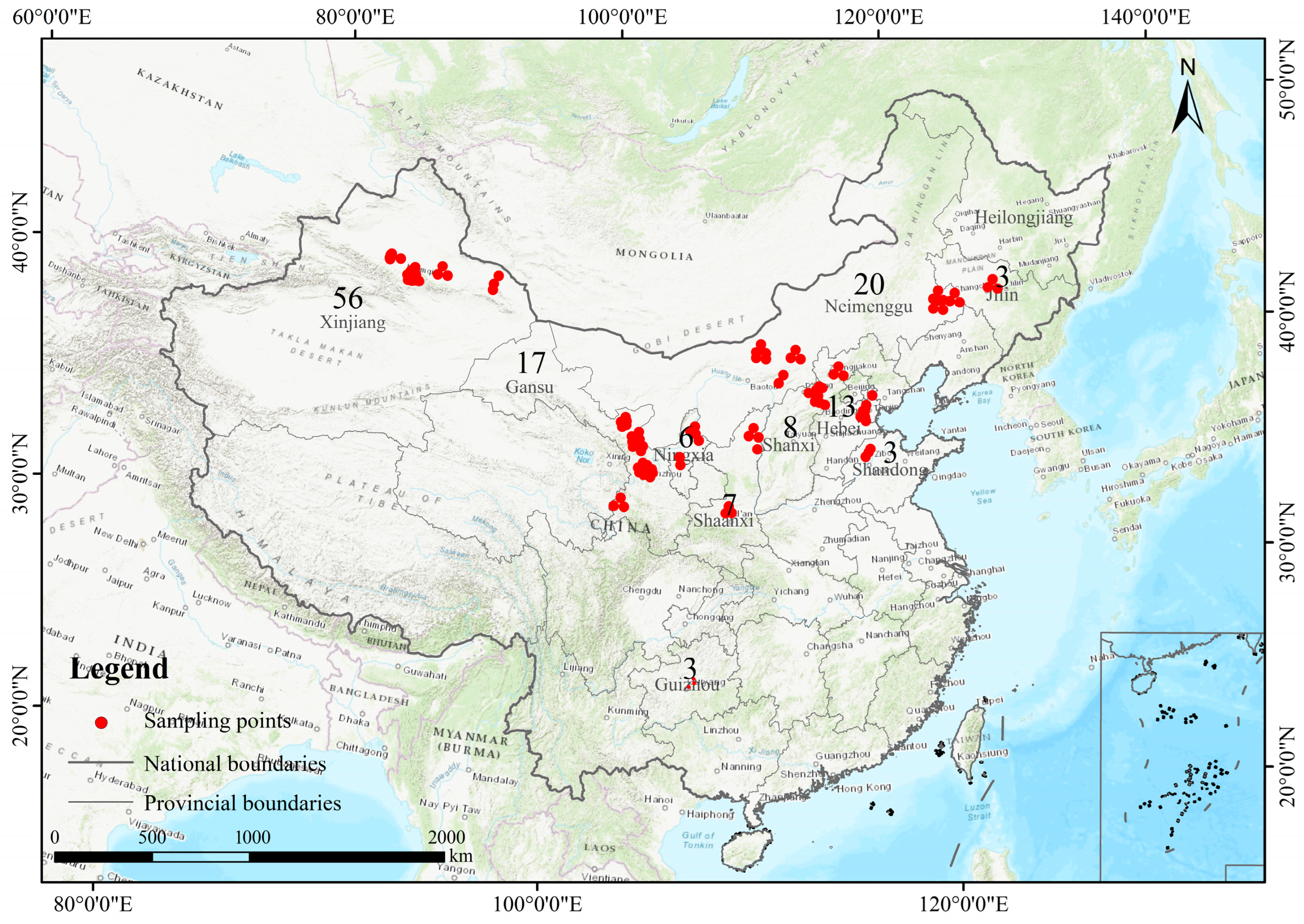
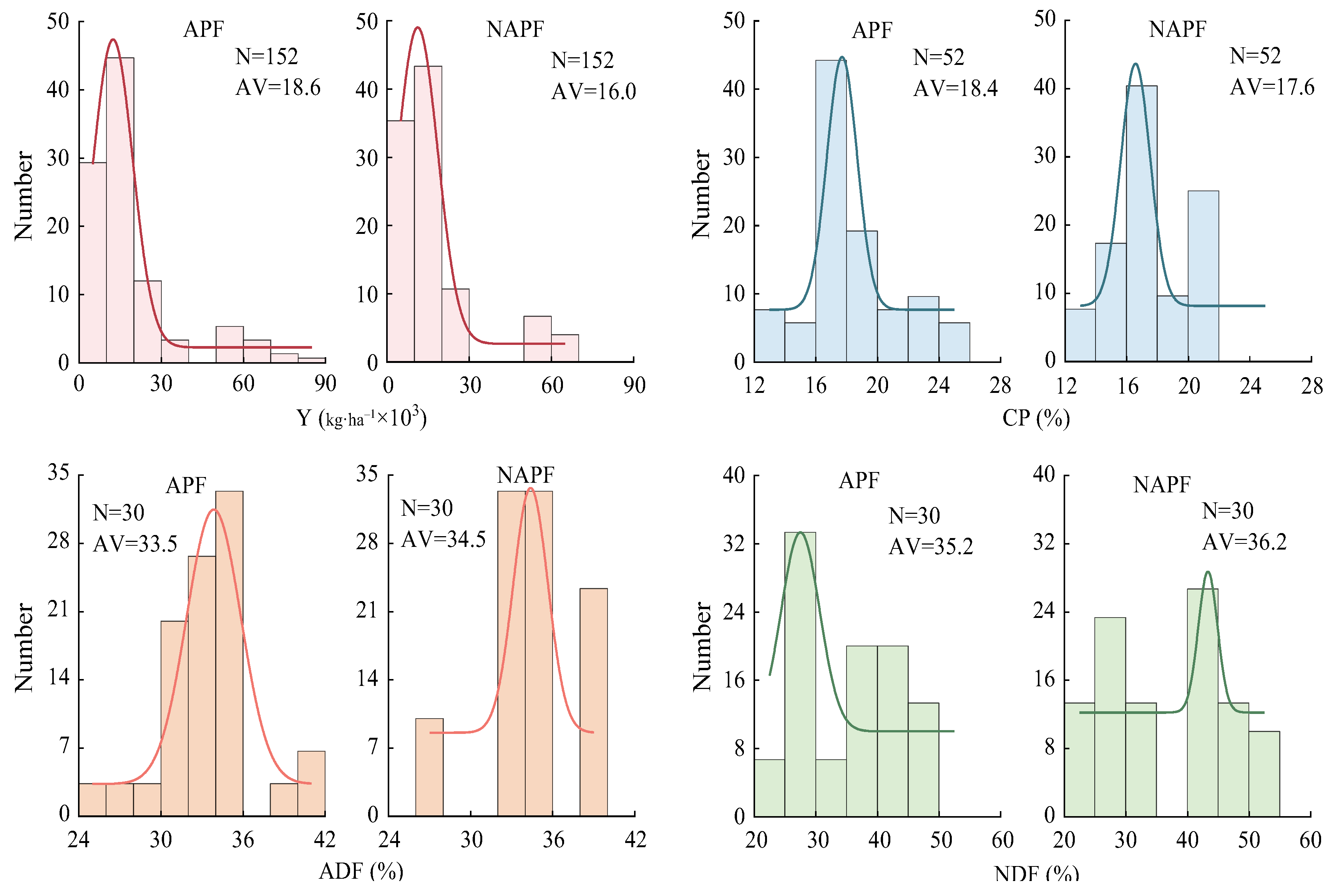

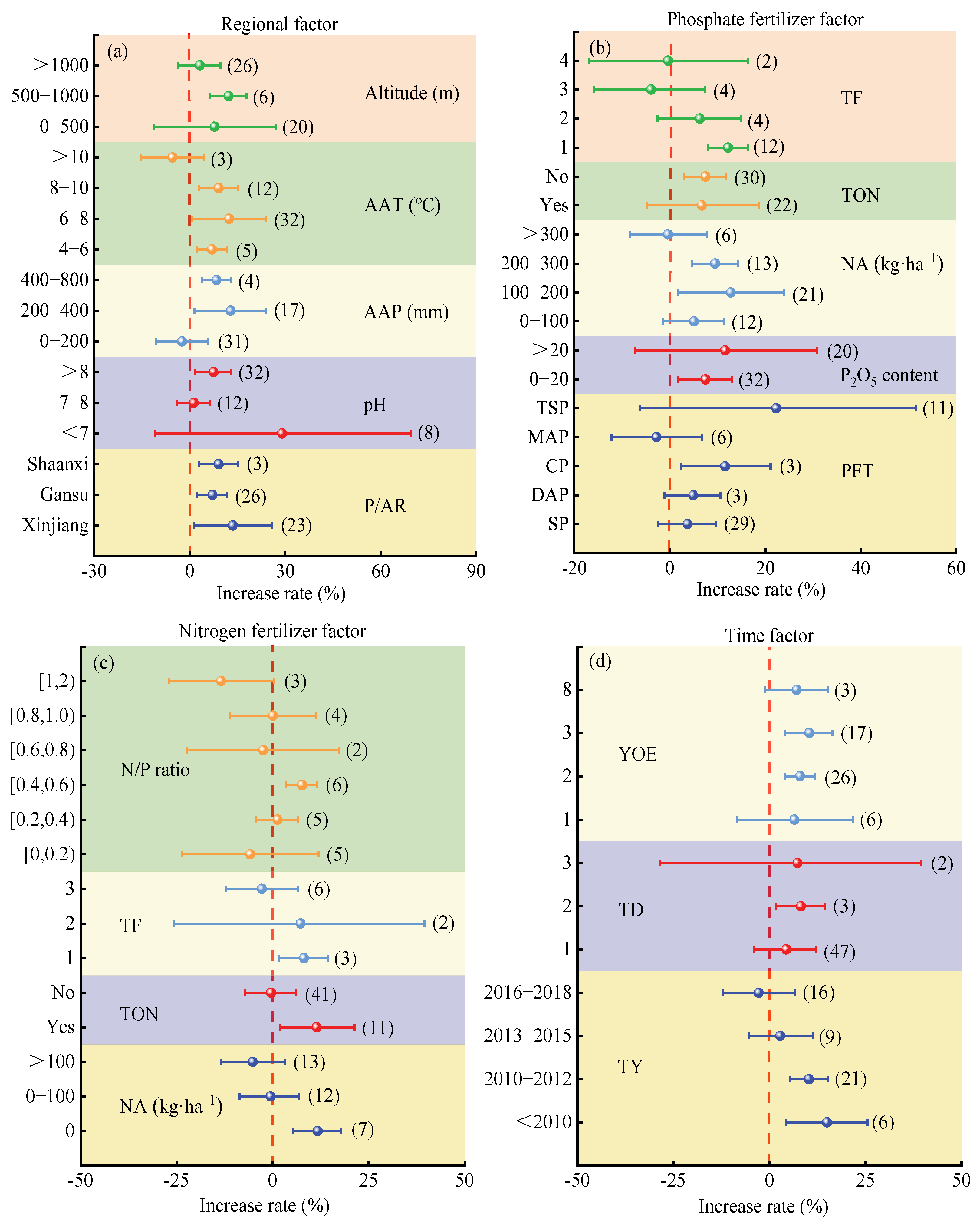
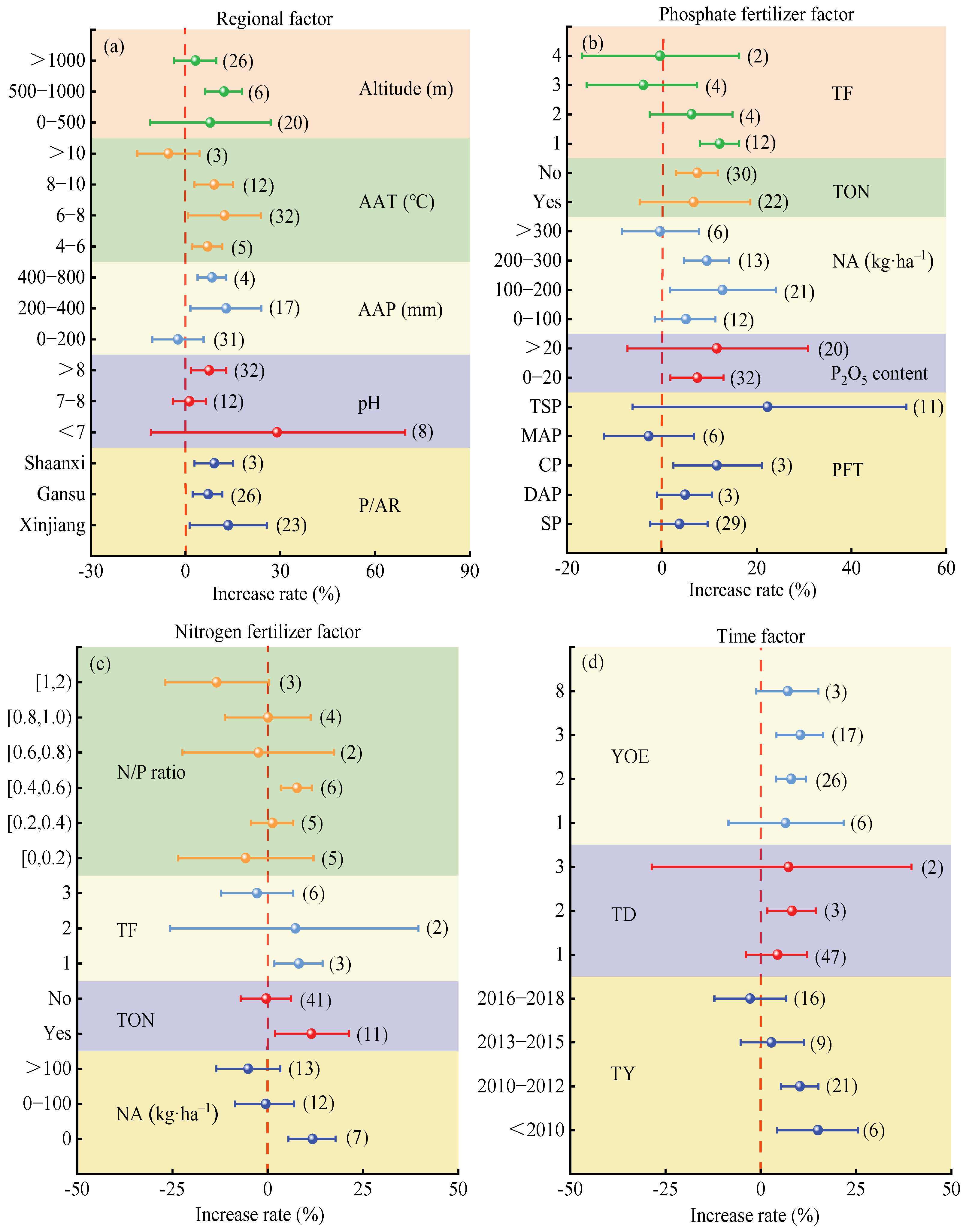
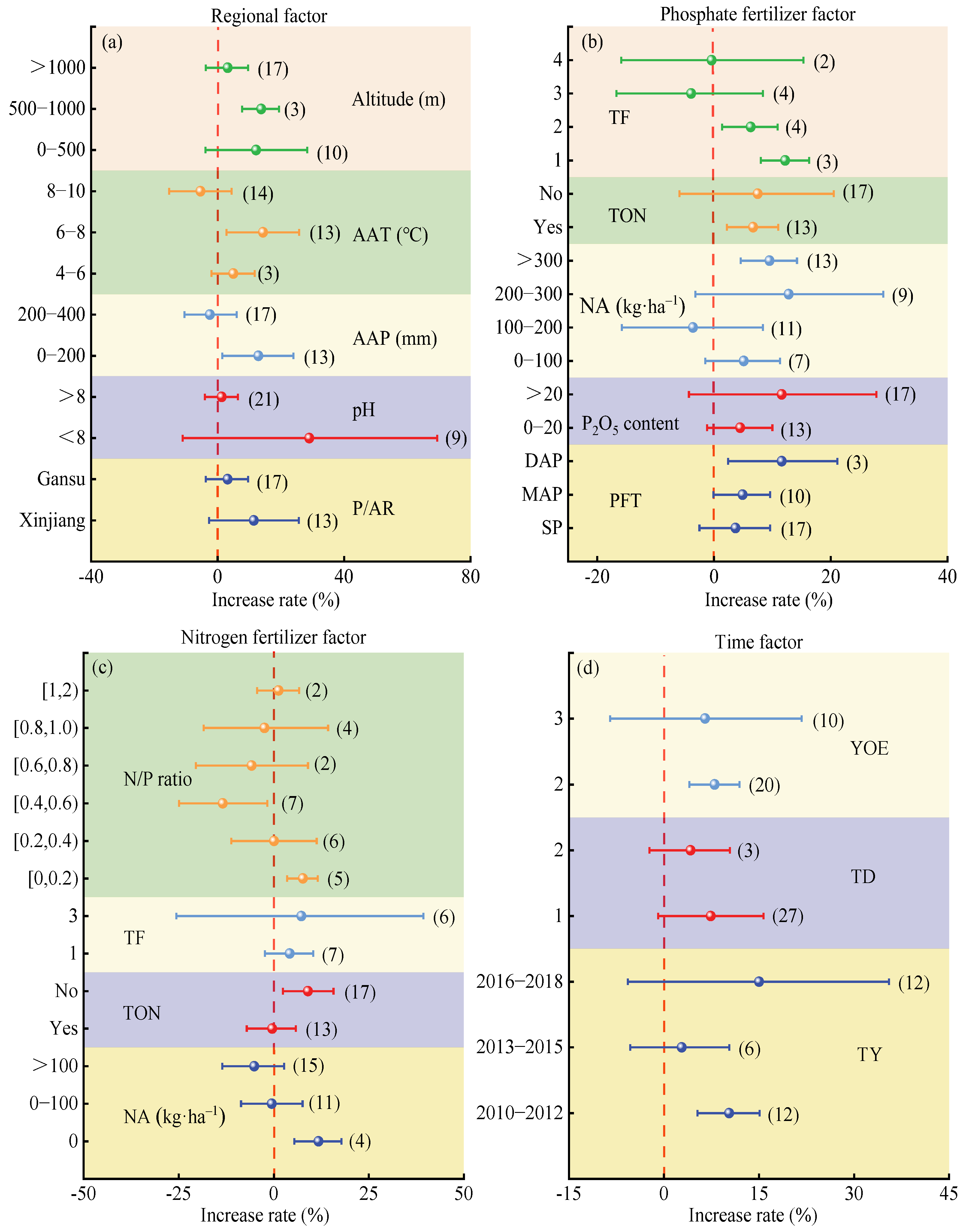
| Influencing Factor | Subcategories | Norm | Criteria for Grouping | |||||||||
|---|---|---|---|---|---|---|---|---|---|---|---|---|
| Region | Geographical distribution | P/AR | Xinjiang | Gansu | LM | Hebei | Shaixi | Shaaixi | Ningxia | Guizhou | Shandong | Jilin |
| Soil characteristics | pH | 5~6 | 6~7 | 7~8 | >8 | − | − | − | − | − | − | |
| Climatic conditions | AAP (mm) | 0~200 | 200~400 | 400~800 | >800 | − | − | − | − | − | − | |
| AAT (°C) | <4 | 4~6 | 6~8 | 8~10 | >10 | − | − | − | − | − | ||
| Topographic characteristics | Altitude (m) | 0~500 | 500~1000 | 1000~1500 | >1500 | − | − | − | − | − | − | |
| Phosphate Fertilizer | Fertilizer types | Typology | SP | DAP | CP | MAP | TSP | − | − | − | − | − |
| Application parameters | P2O5 content (%) | 0~20 | 20~40 | >40 | − | − | − | − | − | − | − | |
| NA (kg·ha−1) | 0~100 | 100~200 | 200~300 | >300 | − | − | − | − | − | − | ||
| Fertilizer strategy | TON | Yes | No | − | − | − | − | − | − | − | − | |
| TF | 1 | 2 | 3 | 4 | − | − | − | − | − | − | ||
| Nitrogenous Fertilizer | Application parameters | NA (kg·ha−1) | 0 | 0~100 | >100 | − | − | − | − | − | − | − |
| Fertilizer strategy | TON | Yes | No | − | − | − | − | − | − | − | − | |
| TF | 1 | 2 | 3 | − | − | − | − | − | − | − | ||
| Nutrient balance | N/P ratio | [0,0.2) | [0.2~0.4) | [0.4~0.6) | [0.6~0.8) | [0.8~1.0) | [1~2) | >2 | − | − | − | |
| Time | Trial period | TY | <2010 | 2010~2012 | 2013~2015 | 2015~2018 | 2019~2021 | − | − | − | − | − |
| TD | 1 | 2 | 3 | − | − | − | − | − | − | − | ||
| YOE | 1 | 2 | 3 | 8 | − | − | − | − | − | − | ||
| Indicator | Model | Increase Rate (%) | 95% Confidence Interval | Effect Size Test | Heterogeneity Test | |||
|---|---|---|---|---|---|---|---|---|
| Upper Limit | Lower Limit | Z | p | Q | PQ | |||
| Yield | Random effects model (REM) | 19.0 | 22.6 | 15.5 | 11.540 | 0.000 | 210.712 | 0.000 |
| Crude protein content (CP) | Random effects model (REM) | 7.2 | 14.9 | 0.1 | 1.981 | 0.027 | 956.620 | 0.000 |
| Acid detergent fiber (ADF) | Random effects model (REM) | −3.3 | −0.8 | −3.3 | −2.624 | 0.009 | 61.124 | 0.000 |
| Neutral detergent fiber (NDF) | Random effects model (REM) | 7.2 | 14.9 | 0.1 | 1.981 | 0.027 | 956.620 | 0.000 |
Disclaimer/Publisher’s Note: The statements, opinions and data contained in all publications are solely those of the individual author(s) and contributor(s) and not of MDPI and/or the editor(s). MDPI and/or the editor(s) disclaim responsibility for any injury to people or property resulting from any ideas, methods, instructions or products referred to in the content. |
© 2025 by the authors. Licensee MDPI, Basel, Switzerland. This article is an open access article distributed under the terms and conditions of the Creative Commons Attribution (CC BY) license (https://creativecommons.org/licenses/by/4.0/).
Share and Cite
Zhang, L.; Jiang, Y.; Yin, M.; Ling, Y.; Li, H.; Gan, Y.; Yue, C.; Ma, Y.; Kang, Y.; Qi, G.; et al. Optimizing Phosphorus Fertilization Management Is Conducive to Improving Alfalfa Yield and Quality: A Meta-Analysis. Agriculture 2025, 15, 797. https://doi.org/10.3390/agriculture15080797
Zhang L, Jiang Y, Yin M, Ling Y, Li H, Gan Y, Yue C, Ma Y, Kang Y, Qi G, et al. Optimizing Phosphorus Fertilization Management Is Conducive to Improving Alfalfa Yield and Quality: A Meta-Analysis. Agriculture. 2025; 15(8):797. https://doi.org/10.3390/agriculture15080797
Chicago/Turabian StyleZhang, Lixin, Yuanbo Jiang, Minhua Yin, Yi Ling, Haiyan Li, Yuanxiang Gan, Changfa Yue, Yanlin Ma, Yanxia Kang, Guangping Qi, and et al. 2025. "Optimizing Phosphorus Fertilization Management Is Conducive to Improving Alfalfa Yield and Quality: A Meta-Analysis" Agriculture 15, no. 8: 797. https://doi.org/10.3390/agriculture15080797
APA StyleZhang, L., Jiang, Y., Yin, M., Ling, Y., Li, H., Gan, Y., Yue, C., Ma, Y., Kang, Y., Qi, G., & Wang, Y. (2025). Optimizing Phosphorus Fertilization Management Is Conducive to Improving Alfalfa Yield and Quality: A Meta-Analysis. Agriculture, 15(8), 797. https://doi.org/10.3390/agriculture15080797







